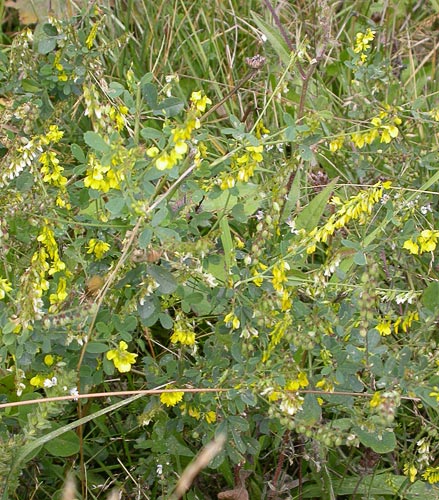Relatives
Melilotus polonicus (L.) Pall. - Polish melilot, Caspian melilot.
Taxonomic position.
Family Fabaceae Lindl., genus Melilotus Mill.Main synonyms:
M. rariflorus Ledeb., M. caspicus Grun.Morphology and biology.
Biennial plant. Stems firm, straight, yellowish, spreadingly branched, 40-70 cm tall, weakly leafed, covered with short hairs in the upper part of plant. Stipules subulate, entire, 6-8 mm long. Leaflets obovate, upper ones acuminate, almost prickly. Leaflets of upper leaves indistinctly dentate or entire at margins, thick, coriaceous, with prominent veins beneath, pubescent with adpressed hairs. Inflorescence a loose raceme about 5 cm long, elongating in fruit. Pedicels filiform, horizontally deflected, 4-5 mm long. Flowers 6 mm long, light yellow. Calyx 3 mm long, pubescent. Calyx teeth acuminate. Standard, wings and keel of the same length. Ovary glabrous, with two ovaries. Pods pendant, large, 7-8 mm long and 3 mm wide, oblong-rhomboid, yellowish or pale brown. Pod valves wrinkled. Seeds smooth, about 3 mm long, yellow-brown, 1, rarely 2 in a pod. Flowers in July, fruits in August. Entomophilous. Zoochore. 2n=16.Distribution.
General distribution: Iran (Caspian coast). Former USSR: European part - Lower Volga; Caucasus - East Transcaucasia, Daghestan; Central Asia - Kara-Kum and Aral-Caspian regions.Ecology.
On sands of Caspian Lowland, sea beach sands, weed along roads.Use and economic value.
Wild relative of cultivated melilot species. Forage.References:
Galushko AI. 1980. Flora of the North Caucasus: Handbook. V.2. P.130-131. (In Russian).Fedorov AA., Tzvelev NN., ed. 1987. Flora of the European part of the USSR. V.6. Leningrad: Nauka. P.181. (In Russian).
Shishkin BK., ed. 1945. Flora URSS. V.11. P.183-184. (In Russian).
Cherepanov SK. 1995. Vascular plants of Russia and adjacent states (the former USSR). St.Petersburg. 990 p. (In Russian).


